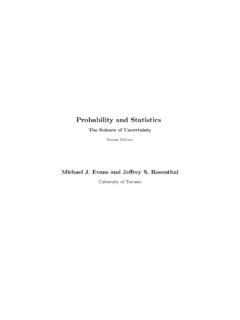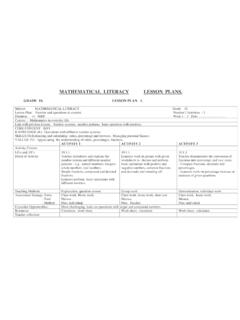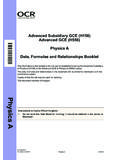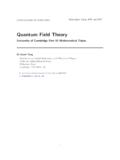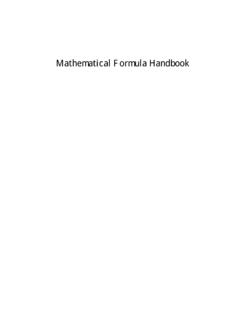Transcription of Mathematics programmes of study: key stage 4
1 Mathematics programmes of study: key stage 4 National curriculum in England July 2014 Mathematics key stage 4 Contents Purpose of study 3 Aims 3 Information and communication technology (ICT) 4 Spoken language 4 Working mathematically 5 Develop fluency 5 Reason mathematically 5 Solve problems 6 Subject content 7 Number 7 Algebra 7 Ratio, proportion and rates of change 9 Geometry and measures 9 Probability 10 Statistics 10 Mathematics key stage 4 3 Purpose of study Mathematics is a creative and highly inter-connected discipline that has been developed over centuries, providing the solution to some of history s most intriguing problems. It is essential to everyday life, critical to science, technology and engineering, and necessary for financial literacy and most forms of employment. A high-quality Mathematics education therefore provides a foundation for understanding the world, the ability to reason mathematically, an appreciation of the beauty and power of Mathematics , and a sense of enjoyment and curiosity about the subject.
2 Aims The national curriculum for Mathematics aims to ensure that all pupils: become fluent in the fundamentals of Mathematics , including through varied and frequent practice with increasingly complex problems over time, so that pupils develop conceptual understanding and the ability to recall and apply knowledge rapidly and accurately. reason mathematically by following a line of enquiry, conjecturing relationships and generalisations, and developing an argument, justification or proof using mathematical language can solve problems by applying their Mathematics to a variety of routine and non-routine problems with increasing sophistication, including breaking down problems into a series of simpler steps and persevering in seeking solutions. Mathematics is an interconnected subject in which pupils need to be able to move fluently between representations of mathematical ideas.
3 The programme of study for key stage 4 is organised into apparently distinct domains, but pupils should develop and consolidate connections across mathematical ideas. They should build on learning from key stage 3 to further develop fluency, mathematical reasoning and competence in solving increasingly sophisticated problems. They should also apply their mathematical knowledge wherever relevant in other subjects and in financial contexts. The expectation is that the majority of pupils will move through the programme of study at broadly the same pace. However, decisions about when to progress should always be based on the security of pupils understanding and their readiness to progress. Pupils who grasp concepts rapidly should be challenged through being offered rich and sophisticated problems before any acceleration through new content. Those who are not sufficiently fluent with earlier material should consolidate their understanding, including through additional practice, before moving on.
4 This programme of study specifies: the mathematical content that should be taught to all pupils, in standard type; and additional mathematical content to be taught to more highly attaining pupils, in bold type and braces { }. Mathematics key stage 4 Together, the mathematical content set out in the key stage 3 and key stage 4 programmes of study covers the full range of material contained in the GCSE Mathematics qualification. Wherever it is appropriate, given pupils security of understanding and readiness to progress, pupils should be taught the full content set out in this programme of study. Information and communication technology (ICT) Calculators should not be used as a substitute for good written and mental arithmetic. In secondary schools, teachers should use their judgement about when ICT tools should be used. Spoken language The national curriculum for Mathematics reflects the importance of spoken language in pupils development across the whole curriculum cognitively, socially and linguistically.
5 The quality and variety of language that pupils hear and speak are key factors in developing their mathematical vocabulary and presenting a mathematical justification, argument or proof. They must be assisted in making their thinking clear to themselves as well as others and teachers should ensure that pupils build secure foundations by using discussion to probe and remedy their misconceptions. Schools are not required by law to teach the example content in [square brackets] or the content indicated as being non-statutory . Mathematics key stage 4 5 Key stage 4 Working mathematically Through the Mathematics content, pupils should be taught to: Develop fluency consolidate their numerical and mathematical capability from key stage 3 and extend their understanding of the number system to include powers, roots {and fractional indices} select and use appropriate calculation strategies to solve increasingly complex problems, including exact calculations involving multiples of {and surds}, use of standard form and application and interpretation of limits of accuracy consolidate their algebraic capability from key stage 3 and extend their understanding of algebraic simplification and manipulation to include quadratic expressions, {and expressions involving surds and algebraic fractions} extend fluency with expressions and equations from key stage 3, to include quadratic equations, simultaneous equations and inequalities move freely between different numerical, algebraic.
6 Graphical and diagrammatic representations, including of linear, quadratic, reciprocal, {exponential and trigonometric} functions use mathematical language and properties precisely. Reason mathematically extend and formalise their knowledge of ratio and proportion, including trigonometric ratios, in working with measures and geometry, and in working with proportional relations algebraically and graphically extend their ability to identify variables and express relations between variables algebraically and graphically make and test conjectures about the generalisations that underlie patterns and relationships; look for proofs or counter-examples; begin to use algebra to support and construct arguments {and proofs} reason deductively in geometry, number and algebra, including using geometrical constructions interpret when the structure of a numerical problem requires additive, multiplicative or proportional reasoning Mathematics key stage 4 explore what can and cannot be inferred in statistical and probabilistic settings, and express their arguments formally assess the validity of an argument and the accuracy of a given way of presenting information.
7 Solve problems develop their mathematical knowledge, in part through solving problems and evaluating the outcomes, including multi-step problems develop their use of formal mathematical knowledge to interpret and solve problems, including in financial contexts make and use connections between different parts of Mathematics to solve problems model situations mathematically and express the results using a range of formal mathematical representations, reflecting on how their solutions may have been affected by any modelling assumptions select appropriate concepts, methods and techniques to apply to unfamiliar and non-routine problems; interpret their solution in the context of the given problem. Mathematics key stage 4 7 Subject content Number In addition to consolidating subject content from key stage 3, pupils should be taught to: apply systematic listing strategies, {including use of the product rule for counting} {estimate powers and roots of any given positive number} calculate with roots, and with integer {and fractional} indices calculate exactly with fractions, {surds} and multiples of ; {simplify surd expressions involving squares [for example 12434323= = = ] and rationalise denominators} calculate with numbers in standard form A 10n, where 1 A < 10 and n is an integer {change recurring decimals into their corresponding fractions and vice versa} identify and work with fractions in ratio problems apply and interpret limits of accuracy when rounding or truncating, {including upper and lower bounds}.
8 Algebra In addition to consolidating subject content from key stage 3, pupils should be taught to: simplify and manipulate algebraic expressions (including those involving surds {and algebraic fractions}) by: factorising quadratic expressions of the form 2++xbx c2axbxc++, including the difference of two squares; {factorising quadratic expressions of the form } simplifying expressions involving sums, products and powers, including the laws of indices know the difference between an equation and an identity; argue mathematically to show algebraic expressions are equivalent, and use algebra to support and construct arguments {and proofs} where appropriate, interpret simple expressions as functions with inputs and outputs; {interpret the reverse process as the inverse function ; interpret the succession of two functions as a composite function } Mathematics key stage 4 use the form = +ymx c to identify parallel {and perpendicular} lines; find the equation of the line through two given points, or through one point with a given gradient identify and interpret roots, intercepts and turning points of quadratic functions graphically.
9 Deduce roots algebraically {and turning points by completing the square} recognise, sketch and interpret graphs of linear functions, quadratic functions, simple cubic functions, the reciprocal function 1=yxcosyx=with x 0, {the exponential function xyk=sinyx= for positive values of k, and the trigonometric functions (with arguments in degrees) , and tanyx= for angles of any size} {sketch translations and reflections of the graph of a given function} plot and interpret graphs (including reciprocal graphs {and exponential graphs}) and graphs of non-standard functions in real contexts, to find approximate solutions to problems such as simple kinematic problems involving distance, speed and acceleration {calculate or estimate gradients of graphs and areas under graphs (including quadratic and other non-linear graphs), and interpret results in cases such as distance-time graphs, velocity-time graphs and graphs in financial contexts} {recognise and use the equation of a circle with centre at the origin; find the equation of a tangent to a circle at a given point} solve quadratic equations {including those that require rearrangement} algebraically by factorising, {by completing the square and by using the quadratic formula}; find approximate solutions using a graph solve two simultaneous equations in two variables (linear/linear {or linear/quadratic}) algebraically; find approximate solutions using a graph {find approximate solutions to equations numerically using iteration} translate simple situations or procedures into algebraic expressions or formulae .
10 Derive an equation (or two simultaneous equations), solve the equation(s) and interpret the solution solve linear inequalities in one {or two} variable{s}, {and quadratic inequalities in one variable}; represent the solution set on a number line, {using set notation and on a graph} recognise and use sequences of triangular, square and cube numbers, simple arithmetic progressions, Fibonacci type sequences, quadratic sequences, and simple geometric progressions (r n where n is an integer, and r is a positive rational number {or a surd}) {and other sequences} deduce expressions to calculate the nth term of linear {and quadratic} sequences. Mathematics key stage 4 9 Ratio, proportion and rates of change In addition to consolidating subject content from key stage 3, pupils should be taught to: compare lengths, areas and volumes using ratio notation and/or scale factors; make links to similarity (including trigonometric ratios) convert between related compound units (speed, rates of pay, prices, density, pressure) in numerical and algebraic contexts understand that X is inversely proportional to Y is equivalent to X is proportional to 1Y; {construct and} interpret equations that describe direct and inverse proportion interpret the gradient of a straight line graph as a rate of change; recognise and interpret graphs that illustrate direct and inverse proportion {interpret the gradient at a point on a curve as the instantaneous rate of change.}











